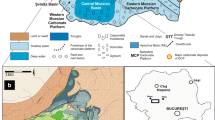Abstract
Spil Mountain (Manisa, western Turkey) is situated in the Bornova Flysch Zone, which is bounded by the İzmir–Ankara Suture Zone (northern branch of Neo-Tethys) to the northwest and by the Menderes Massif to the southeast. The purpose of this study is to describe microfacies and microfossil assemblages of the Spil Mountain carbonate sequences. Two carbonate sequences in autochthonous and allochthonous settings are differentiated. The autochthonous sequence begins with inner-platform carbonates of Early Cretaceous age, which are represented by algal wackestone, fenestral mudstone, intraclastic packstone with Praechrysalidina infracretacea, Salpingoporella annulata, and charophyte oogonia. The platform succession is disconformably overlain by calciclastic turbidites and pelagic wackestones of Maastrichtian age, representing platform drowning, and then passes upward into siliciclastic sediments containing large limestone blocks. Allochthonous carbonate sequences range in age from the ?Cenomanian to Santonian–early Campanian, and were deposited in peritidal to outer-shelf palaeoenvironments. The lower part of the allochthonous sequence is composed of foraminiferal–intraclastic wackestones–packstones with mainly miliolids and Cuneolina pavonia. The middle part consists of peloidal wackestone/packstone with Aeolisaccus, Thaumatoporella, benthic foraminifers, and rudist shell fragments. The benthic foraminifera are represented by Pseudocyclammina sphaeroidea, Keramosphaerina tergestina, Moncharmontia apenninica/compressa, and Scandonea samnitica. In the upper part of the allochthonous sequence, pelagic wackestone with Marginotruncana and Dicarinella is alternated with foraminiferal–peloidal packstone with rudist shell fragments and microbioclastic wackestone.
Access provided by Autonomous University of Puebla. Download conference paper PDF
Similar content being viewed by others
Keywords
Introduction
The Bornova Flysch Zone (BFZ) forms a 50–90-km-wide and ~230-km-long tectonic zone between the Menderes Massif and the İzmir–Ankara suture (Okay and Altiner 2007) (Fig. 1). The BFZ consists of large blocks of Mesozoic limestone, basalt, serpentinite, and radiolarian chert in a highly sheared clastic matrix of latest Cretaceous to Palaeocene age. Limestone blocks reach up to 20 km in size and range from the Late Triassic to Late Cretaceous in age (Erdoğan 1990). Some workers have considered the carbonate sequences in Spil Mountain (Fig. 2) as blocks derived from the Mesozoic platform carbonate sequence in the Karaburun Peninsula and Chios Island, whereas others have conversely proposed them as in situ sequences subsequently sliced and deformed.
a Main tectonic units of western Anatolia (Görür and Tüysüz 2001). Spil Mountain is situated in the Bornova Flysch Zone (BFZ). IAS İzmir–Ankara Suture. b Simplified geological map of Spil Mountain (after Güngör 1986). a Neogene units; b flysch; c pelagic limestone (Maastrichtian); d platform carbonate rocks; e pelagic wackestone–microbioclastic wackestone/mudstone alternation (Santonian–lower Campanian)
Materials and Methods
Microfacies and microfossil identifications were based on approximately 200 thin-sections of limestone samples, collected from the fourteen stratigraphic sections (Fig. 1a). A composite stratigraphic section (Fig. 2b) of allochthonous sequences is based on the integration of many local stratigraphic sections that are separated by post-Miocene vertical faults.
Results and Conclusions
The Spil Mountain carbonate rocks comprise autochthonous and allochthonous sequences ranging in age from the Early Cretaceous (Neocomian), probable Cenomanian, to Santonian–early Campanian. In the autochthonous sequence, the Lower Cretaceous inner platform carbonate succession (Lithofacies 1) includes algal wackestone (Fig. 3a), fenestral mudstone, and intraclastic–foraminiferal packstone microfacies with Preaechrysalidina infracretacea and Salpingoporella annulata.
Microfacies types in thin sections. a algal wackestone (Lower Cretaceous); b lithoclastic packstone with planktic foraminifera; c grainstone with rudist shell fragments and Orbitoides; d planktic foraminiferal wackestone (b–d Maastrichtian drowning microfacies); e miliolid packstone (?Cenomanian); f Planktic foraminiferal wackestone and microbioclastic wackestone–mudstone alternation. The scale bar is 0.2 mm
The unconformably overlying calciclastic turbidites (Lithofacies 2) and pelagic limestones (Lithofacies 3) composed of lithoclastic–bioclastic packstone with Orbitoides and planktic foraminiferal wackestone microfacies are of Maastrichtian age and represent the platform-drowning event. The lower part of the allochthonous sequence is composed of nonfossiliferous limestone and dolomitized limestone (Lithofacies 4), which consist of wackestone/packstone microfacies. A probable Cenomanian age can be inferred based on the presence of Cuneolina pavonia, Pseudonummoloculina regularis, and Nezzazata simplex.
The most prominent lithofacies of the Spil Mountain carbonate sequences is rudist-bearing limestones (Lithofacies 5), which include poorly sorted bioclastic packstone and foraminiferal–peloidal wackestone with Aeolisaccus and Thaumatoporella. The exposed uppermost part of the allochthonous sequence is characterized by pelagic wackestone (Lithofacies 6), which is alternated over a mm–dm-scale with microbioclastic wackestone and mudstone. Lithofacies 5 and 6 are assigned to a Santonian–early Campanian age based on benthic (Fig. 4) and planktic foraminiferal assemblages.
References
Erdoğan, B. (1990). İzmir-Ankara Zonu’ nun, İzmir ile Seferihisar arasındaki bölgede stratigrafik özellikleri ve tektonik evrimi. Türkiye Petrol Jeologları Derneği Bülteni,2, 1–20.
Görür, N., & Tüysüz, O. (2001). Cretaceous to Miocene Palaeogeographic evolution of Turkey: Implications for hydrocarbon potential. Journal of Petroleum Geology,24, 1–28.
Güngör, T. (1986). Manisa Güneyinin Jeolojisi. DEÜ, Müh.-Mim. Fak., Jeol. Müh. Böl., Bitirme Ödevi, Bornova, 27 sayfa (unpublished).
Okay, A. Y., & Altiner, D. (2007). A condensed Mesozoic succession North of İzmir: A fragment of the Anatolide-Tauride platform in the Bornova Flysch Zone. Turkish Journal of Earth Sciences,16, 1–23.
Author information
Authors and Affiliations
Corresponding author
Editor information
Editors and Affiliations
Rights and permissions
Copyright information
© 2014 Springer-Verlag Berlin Heidelberg
About this paper
Cite this paper
Solak, C., Taslı, K., Özer, S. (2014). Stratigraphy and Microfacies of Cretaceous Limestones in the Bornova Flysch Zone (Spil Mountain, Manisa, Western Turkey). In: Rocha, R., Pais, J., Kullberg, J., Finney, S. (eds) STRATI 2013. Springer Geology. Springer, Cham. https://doi.org/10.1007/978-3-319-04364-7_115
Download citation
DOI: https://doi.org/10.1007/978-3-319-04364-7_115
Published:
Publisher Name: Springer, Cham
Print ISBN: 978-3-319-04363-0
Online ISBN: 978-3-319-04364-7
eBook Packages: Earth and Environmental ScienceEarth and Environmental Science (R0)








